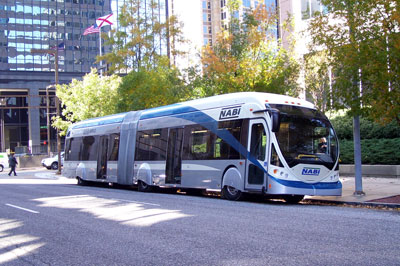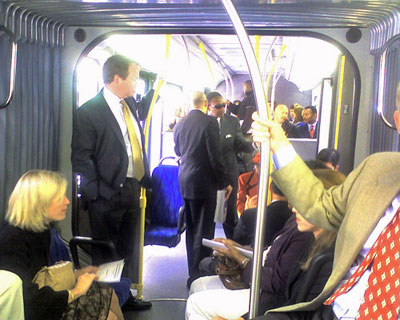
Truth be told, I almost started this post with a lie. I almost said that I hadn’t ridden on a bus for more than two years. Not counting a ride on the bus that connects the commuter train in Baltimore with Thurgood Marshall BWI last November, my last transit bus ride was in August 2005 while home in New York. Much of the subway stations in lower Manhattan are still not accessible years after 9/11, so construction during weekends mean that surface routes are used to get from point A to point B. In my case, point B was the Staten Island Ferry. Having grown up with one of the nation’s larger bus systems, I am aware of many of the complaints that are logged against using buses. Birmingham residents would not have any of those complaints available to them if they choose to go with a bus designed and built in-state. They’d also be assisting with the economy while providing a taste of what 21st century transit could be like.
The Birmingham News ran this story on the appearance of the bus this morning.
Hybrid-fuel bus attracts attention, The Birmingham News, November 3, 2006
I was able to take part in the second demonstration route traveled by the NABI BRT60. The fact that it runs on rubber tires is the only major similarity to many conventional buses. For those that do the morning commute in cities like Chicago and New York, the amenities would resemble their subways and els more than their buses. One of the most notable differences is the existence of doors on both sides of the bus, allowing for them to run in dedicated lanes and allowing for passengers to get off the bus safely whether on a one-way or two-way street (never interacting with traffic). The bus is also much longer than a normal bus; 60 feet instead of 40. Bucket seats with LED displays overhead that could be used to inform passengers of traveling distances and next stops. Passengers would pay before getting on the bus, again operating more like commuter trains than buses. The rubber floors, low to the ground, and available WiFi access would provide creature comforts that are not even currently available on most systems. The best way to express all of this is to show it, thanks to Curtis.

Yesterday we provided links in the post to examples of other systems that are in existence, even if only in an experimental phase, around the country and the world. It’s definitely something to consider in addition to some of the other alternatives being examined. Based on comments printed in the News’ article and comments overheard during my ride on the bus yesterday, I’d say that the first impression is one that may finally change some people’s negative views of riding the bus. Transportation is key to the history of this city. We should embrace it as part of our strategy to renew it.
It would not be a Friday without mentioning a couple of things happening this weekend. My quest to take part in the Vulcan Run will come up quite short. At this point, I’m setting an extremely slow target date of the Cooper River Bridge Run in April in Charleston, SC. It was the first race I ever ran, so it would be appropriate for it to be the first one I do getting back in the swing of things. I’m still planning on braving the temps tomorrow morning as there are a few people I know that plan to run the race. Check out the website to learn some more about it.
Two other events that should be an interesting part of the weekend are the first annual Moss Rock Festival and Cosmos Pizza‘s 10th Anniversary celebration, both taking place Saturday. There’s also a chance that people may actually see a certain blogger play kickball on Sunday afternoon, though we’ll have to wait and see.
Enjoy the day.
Cheers.

[…] Andre has more information about the hybrid buses made here in Alabama on his website. http://dresramblings.wordpress.com/2006/11/03/a-big-bus-makes-a-big-impression-yesterday/ […]